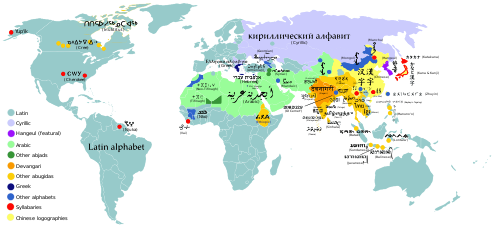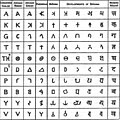Writing system
A writing system (also called a script) is a system of symbols used to represent language.[1][2] There are different kinds of writing systems, with symbols that represent different things. For example, English uses an alphabet (the Latin alphabet).
The fundamental principle is that symbols stand for sound, but there is more to it than that. The term "writing system" includes more than just (for example) an alphabet. Alphabets are part of a "graphic inventory" which includes punctuation, diacritics, ideograms (e.g. numbers) and logograms (standing for specific words such as $, & etc.).
Types of writing systems
There are many different types of writing systems. Each grapheme, or symbol, can mean different things in different writing systems. Depending on what an individual symbol means, such as a whole word or a sound, each writing system is categorized as a different type.
Phonetic
A phonetic writing system is one where symbols mean individual sounds (or phonemes). There are different types of phonetic writing systems.
Alphabets
A true alphabet is a writing system with symbols that mean both consonants and vowels.
Examples of alphabetic writing systems are the Latin alphabet, (used in large parts of the world), the Greek alphabet (used in Greek), and the Cyrillic alphabet (used in many countries in Eastern Europe and Central Asia, where Russia had a major influence during the days of the Soviet Union).
Abjad
Alphabets that only write consonants (and do not write vowels) are called abjads. The logic is that people in those areas know what vowels are used when the words are spoken. Many modern Abjads use optional diacritics to clarify their vowels, known as an Impure Abjad (less commonly, Voiced Abjad or Alphasyllabary). These are different from vowel letters in alphabets, as they are not written on their own but only as attached to a consonants.
Examples of abjads are the Arabic alphabet, which is used in much of the Muslim world, and the Hebrew alphabet used for Jewish languages like Hebrew and Yiddish. Both of these abjads are written in lines that run from right to left.
Abugida
Abugidas are alphabets where consonants are written as a symbol, and vowels are written as diacritics. Diacritics in Abugidas are mandatory, as the lack of diacritic implies a default vowel sound (e.g. क (k) in Devanagari is pronounced 'ka' with no diacritic).
Examples of abugidas are many writing systems of India and Southeast Asia, such as Devanagari (used in Hindi and Sanskrit).
Syllabary
A syllabary is a writing system with symbols that each mean a syllable. This is different from Abugidas, as syllables with similar consonant or vowel sounds do not necessarily share similar symbols (e.g. か (ka) and き (ki) in Japanese).
Examples of syllabaries are hiragana and katakana (used in Japanese) and the Cherokee syllabary (used in Cherokee).
Logographic
A logography is a writing system with symbols that mean whole words or symbols that represent ideas. These symbols are called "logograms" or "logographs". In practice, no writing system is fully logographic: many symbols are combinations where one part represents the sound and another part represents the meaning. (e.g. 女 (nǚ), “woman”, and 马 (mǎ), “horse”, create 妈 (mā) "mother" in Mandarin Chinese).
Examples of logographies are Chinese characters (used in Chinese) and hieroglyphs.
Direction of writing
Each writing system can be written in different directions. English (which uses the Latin alphabet) is written from left to right. Some languages, like Arabic, are written from right to left.
Some languages, like Chinese and Japanese, can be written vertically (from top to bottom), and also like Hanuoo, can also be written vertically (from bottom to top).
Beside written be horizontally and vertically, theorically can be written diagonally but never exist.
Writing System Media
The relationship between spoken, written, and signed modes of language, as modelled by Beatrice Primus et al.[3] While many spoken or signed languages are not written, there are no written languages without a spoken counterpart that they originally emerged to record.
Comparison between double-storey Template:Gph (left) and single-storey Template:Gph (right) lowercase forms of the Latin letter ⟨A⟩
Table of scripts in the introduction to the Sanskrit–English Dictionary by Monier Monier-Williams
A stop sign in Tahlequah, Oklahoma written in Cherokee using both the Cherokee syllabary (top) and Latin alphabet (middle), alongside English (bottom)
A passage from the biblical Gospel of Luke printed using Balinese script
Related pages
- Writing tool
- Constructed script - a writing system made by someone for a specific purpose
References
- ↑ Martin H-J. 1994. The history and power of writing. Chicago University Press. ISBN 0-226-50836-6
- ↑ Diringer, David. 1965. Writing. London, Thames & Hudson.
- ↑ Meletis & Dürscheid (2022), p. 17; Primus (2003), p. 6.





